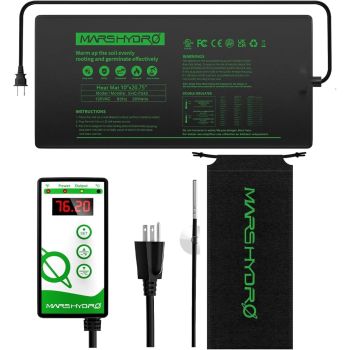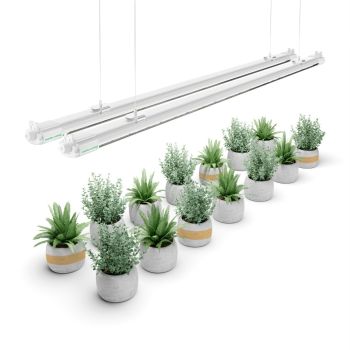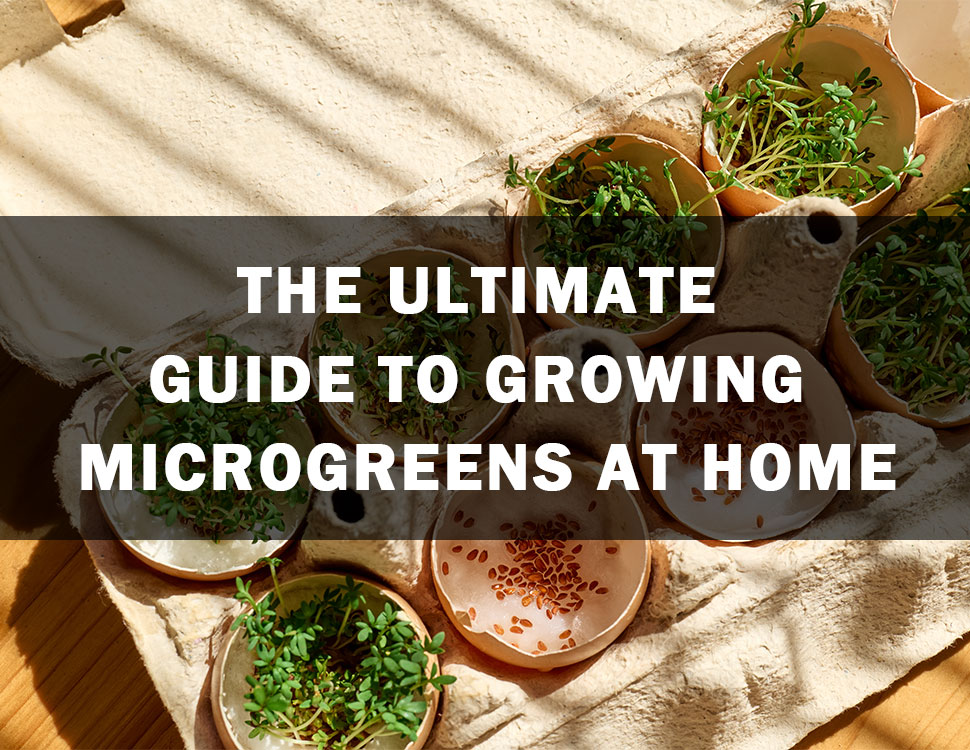
Microgreens have transformed modern culinary experiences, not just in upscale restaurants but also in home kitchens around the globe. These tiny microgreens, often harvested from edible vegetables like kale, arugula, radish, and broccoli, pack a nutritional punch far beyond their size. If you're intrigued by the idea of adding freshness, flavor, and visual appeal to your dishes while reaping health benefits, read on. Growing microgreens is an accessible, rewarding endeavor that brings the garden indoors, providing fresh greens year-round.
In this guide, you'll learn:
What Are Microgreens?
Microgreens are vibrant, flavorful young vegetable greens harvested shortly after the first true leaves appear. These tiny powerhouses are cultivated from the seeds of various edible vegetables and herbs, such as kale, arugula, radishes, and basil. Despite their small size, microgreens pack a significant nutritional punch, often containing higher levels of vitamins C, E, and beta carotene compared to their mature counterparts. This makes them not only a delicious addition to meals but also a potent ally in enhancing health and reducing the risk of cardiovascular disease.
Growing microgreens is a simple and accessible endeavor, perfect for indoor gardening year-round, even in limited spaces. They thrive in a variety of mediums, including organic potting mixes or hydroponic setups, and are easy to start with kits available at most garden centers or grocery stores. With just a sunny spot or a grow light, these greens sprout quickly, ready to harvest in about two weeks. This rapid growth cycle allows for a continuous supply of fresh greens, enriching your diet with essential nutrients and flavors.
Incorporating microgreens into your meals is a breeze—they can elevate a simple salad, add crunch and flavor to sandwiches, or boost the nutritional content of smoothies and other dishes. Growing your own microgreens is not just about enjoying the freshest possible produce; it's also about the joy and satisfaction of cultivating your food, knowing it contributes to a healthier diet. With their ease of growth, exceptional nutrient content, and versatile culinary uses, microgreens are a splendid addition to any kitchen, offering a taste of gardening success and dietary enhancement with minimal effort.
The Essentials for Growing Microgreens at Home
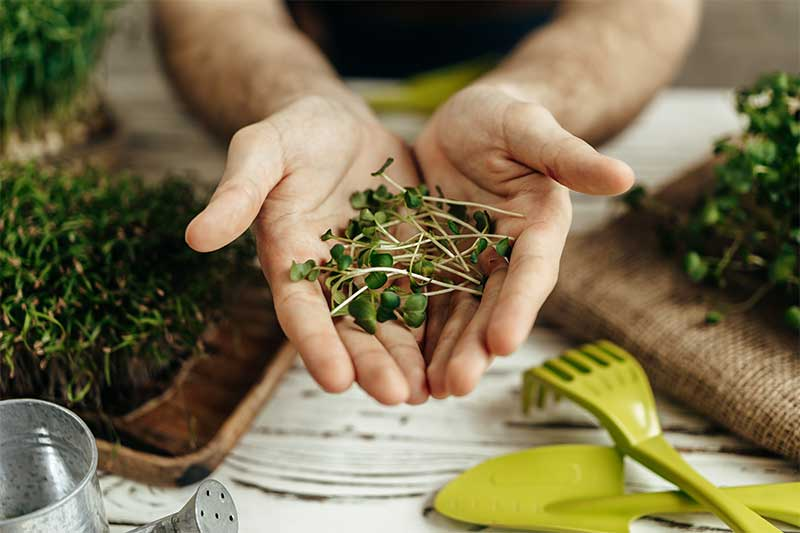
To embark on your microgreen gardening journey, you'll need a simple set of supplies, readily available at most garden centers or even at your local grocery store. Here’s what you should gather to ensure a successful microgreen crop:
- Seeds: The foundation of your microgreen garden, seeds can be selected from an array of edible vegetables and herbs known for their robust flavors and nutritional benefits. Popular options include kale for its vitamin-rich leaves, spicy arugula, fragrant basil, sweet peas, and vibrant red cabbage microgreens. These varieties not only bring a spectrum of tastes to your dishes but also a wealth of nutrients.
- Growing Medium: Opt for an organic potting mix or soil as your growing medium to stay true to organic gardening practices. The ideal mix should be free from pesticides and chemicals, ensuring that your microgreens grow in a safe, nutrient-rich environment.
- Trays: Since microgreens have shallow roots and require minimal soil, shallow trays are perfect. These ensure your little greens have enough room to sprout without the excess bulk of deeper containers.
- Light Source: Adequate light is crucial for the growth of healthy, vibrant microgreens. A grow light is ideal for consistent, year-round growing conditions. However, if you prefer a more natural approach, placing your trays in a sunny spot where they can bask in natural sunlight will also encourage thriving growth.
- Watering Supplies: Microgreens need to be watered in a way that keeps the soil moist but not waterlogged. A spray bottle is the perfect tool for this, allowing you to gently mist the soil surface without disturbing the delicate seeds or their emerging roots.
With these essentials, growing microgreens at home becomes an accessible and enjoyable endeavor. Whether you’re looking to enhance your meals with fresh greens, add more nutrients to your diet, or simply enjoy the process of growing your own food, microgreens offer a quick, rewarding gardening experience.
Step-by-Step Guide to Grow Microgreens
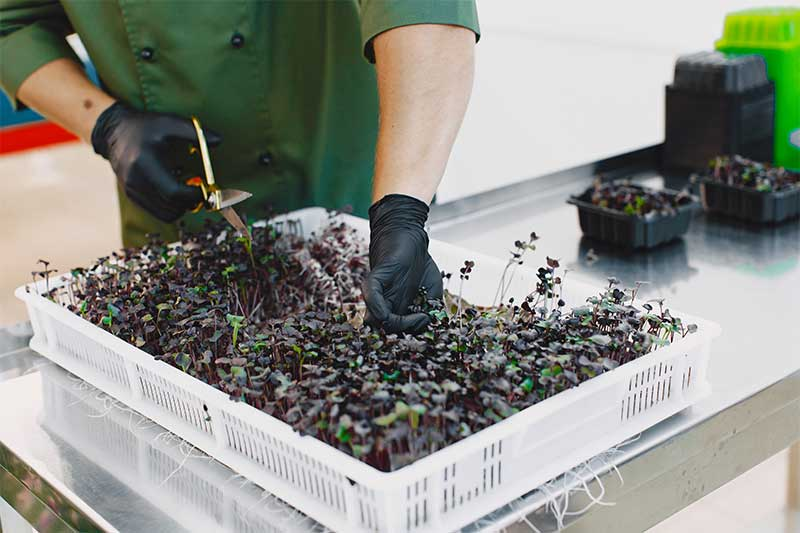
Growing microgreens indoors allows you to enjoy fresh greens without worrying about pesticides or the trip to the grocery store. It's a step towards self-sufficiency, reducing your carbon footprint, and eating healthier. Plus, the act of nurturing these plants from seed to harvest is incredibly rewarding.
1. Prepare Your Growing Medium and Trays
To start growing microgreens, prepare your trays by filling them with a damp organic potting mix, ensuring the surface is level and just below the soil line. This method essentially creates a compact, mini vertical farming system that's ideal for small spaces, allowing for efficient use of area while promoting healthy root development and easy access for light and air to your soon-to-be sprouted greens.
2. Sow Your Seeds
When sowing your microgreen seeds, distribute them evenly across the top of the soil. For varieties such as radishes and broccoli, there's no need to bury the seeds deep within the soil. A light press to make sure each seed is in contact with the moist potting mix is sufficient. This method ensures optimal germination and growth, as most microgreens thrive with minimal soil coverage, allowing for easier access to light and air, crucial elements for their development.
3. Water and Cover
After sowing, cover the seeds lightly with a damp paper towel, which helps maintain consistent moisture essential for germination. Gently mist the paper towel and soil beneath with a spray bottle to keep them adequately moist without oversaturating. This method ensures the seeds have the optimal environment for sprouting, preventing the soil from drying out and supporting even and healthy growth of your microgreens.
4. Let There Be Light
After your seeds have sprouted, it's time to introduce them to light. Remove the damp paper towel and position the trays under a grow light or in a location that receives ample sunlight. This step is vital for the growth process, as light exposure encourages the microgreens to develop strong, healthy stems and vibrant leaves. Ensuring your sprouts receive enough light is key to nurturing them from tiny seeds into lush, edible greens ready for harvest.
5. Harvest Time
Approximately two weeks after planting, your microgreens will be ripe for harvesting. Look for the sprouts to reach a height of 2-3 inches and display their true leaves, indicating they're at the perfect stage for picking. At this point, grab a pair of scissors and snip the greens right above the soil line, harvesting only what you plan to use. This method ensures you enjoy the freshest taste and highest nutrient content while allowing the remaining microgreens to continue growing undisturbed.
Tips for Success
- Keep the Soil Moist: Microgreens grow best in moist conditions. Use a spray bottle to gently water them daily.
- Provide Enough Light: If you're not using a grow light, place your microgreens near a window that gets plenty of sunlight.
- Harvest Regularly: The more you harvest, the more your microgreens will grow. Plus, regular harvesting encourages fresh growth.
- Experiment: Don't be afraid to try growing different types of microgreens. Each variety offers unique flavors and nutrients.
Including Microgreens in Your Diet
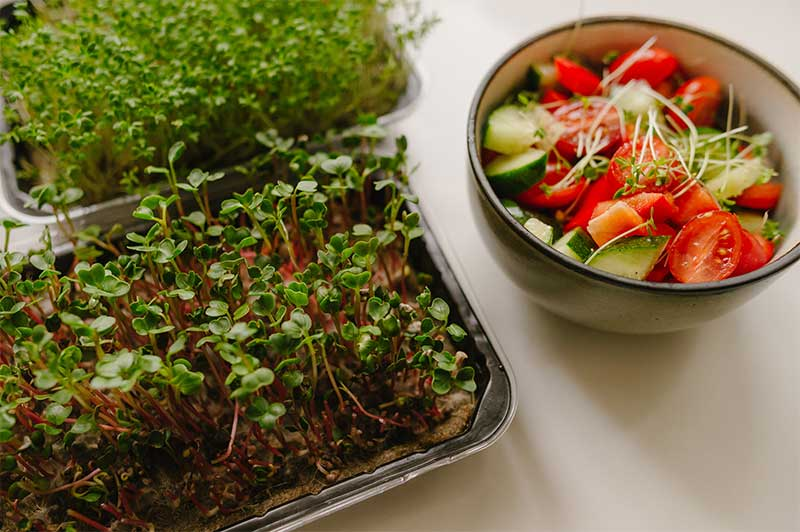
After mastering the art of growing your own vibrant and nutritious microgreens, the next exciting step is to incorporate these tiny, flavorful greens into your daily diet. Not only will this allow you to reap the health benefits they offer, but it also opens up a new world of culinary creativity in your kitchen.
These tiny powerhouses are rich in vitamins, minerals, and antioxidants, providing significant health benefits in just a small serving. Here's how you can easily add them to your daily meals:
- Salads: Elevate your salads by mixing in a variety of fresh microgreens with your chosen greens and veggies. The unique flavors and textures of microgreens like arugula, red cabbage, or pea shoots can transform an ordinary salad into a gourmet dish, enriching it with a dense nutrient profile including Vitamin C, Vitamin E, and beta-carotene.
- Smoothies: For a nutrient-packed start to your day, blend a handful of kale or radish microgreens into your morning smoothie. These greens not only contribute to the smoothie’s vibrant color and fresh taste but also boost its nutritional content, particularly enhancing its Vitamin K, calcium, and iron levels.
- Sandwiches and Wraps: Incorporate microgreens into your sandwiches and wraps for a crunchy texture and a fresh, peppery, or slightly sweet taste, depending on the variety used. Adding microgreens like basil, mustard, or broccoli can elevate a simple sandwich with complex flavors and additional nutrients such as folate and magnesium.
- As a Garnish: Beyond their aesthetic appeal, using microgreens as a garnish adds a concentrated source of nutrients to your dishes. Sprinkle a generous amount of these edible greens over soups, pizzas, omelets, or any main dish to enhance its visual appeal while boosting its vitamin and mineral content.
Microgreens offer a versatile and convenient way to enrich your diet with essential nutrients and elevate the culinary experience of home-cooked meals. Whether used in salads, smoothies, sandwiches, or as a garnish, these tiny greens can have a significant impact on both the healthfulness and flavor profile of your dishes.
Conclusion
Microgreens are not just a food trend; they're a sustainable way to enhance your diet, add flavor to your dishes, and embark on a gardening adventure. Whether you're a seasoned chef looking to elevate your dishes or a home cook aiming to incorporate more greens into your diet, microgreens provide an easy, efficient way to grow your own food and enjoy the myriad of health benefits they offer.
Kick off your microgreen garden today and become part of the growing community of urban farmers and home garden enthusiasts!


